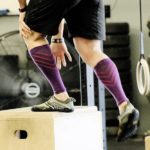In sports columns, the injuries are often described as “horrific” and watching professional athletes like Kevin Ware, Joe Theismann, and most recently, Paul George, suffer tibia and fibula fractures can be brutal. George’s injury happened when he jammed his leg into the bottom of the basketball stanchion (upright goal support) in a FIBA scrimmage in Las Vegas.

Like Ware when he suffered a similar fracture in 2013, George landed awkwardly and sustained an open tibia fibula fracture. In other words, both bones in George’s lower leg were fractured and broke through the skin. Open fractures of the lower leg are common, as the skin covering the tibia (shin) is quite thin.
 George underwent surgery almost immediately. Most people with this type of injury are treated with a surgical technique involving the insertion of a rod in the marrow canal of the tibia which passes through the fracture and holds the bone in position. Screws (also known as intramedullary nails) are then used to further secure the bone as it heals. Another technique involves attaching a metal plate with screws to rejoin the bone segments.
George underwent surgery almost immediately. Most people with this type of injury are treated with a surgical technique involving the insertion of a rod in the marrow canal of the tibia which passes through the fracture and holds the bone in position. Screws (also known as intramedullary nails) are then used to further secure the bone as it heals. Another technique involves attaching a metal plate with screws to rejoin the bone segments.
There is speculation that both Ware and George may have sustained stress fractures that, over time, created weak points in these critical weight-bearing bones. Athletes often sustain stress fractures from the repetitive stress sports put on their bones.
But athletes aren’t the only ones susceptible to stress fractures. Weekend warriors (individuals who spend leisure time doing athletic activities), marathon runners, women, pronators and all highly active individuals are prone to problems affecting the lower legs. Here are a few examples, discussions on diagnosis and treatment, plus prevention tips.
Stress Fractures
The tibia is the strongest weight-bearing bone in your body. It’s about four times as strong as concrete, and like the concrete in your driveway, constant stress and pressure can cause tiny cracks over time.
Cause and symptoms of stress fractures
Stress fractures of the tibia often result from repetitive stress or activities, but can be caused by a sudden increase in activity, such as when an ordinarily sedentary person takes on a strenuous exercise regimen or an active person dramatically increases their training routine. Muscle fatigue can play a role in stress fractures, also. Both muscles and bones serve as shock absorbers. However, when muscles become fatigued after running for a long distance, for example, they lose their ability to dampen shock and this puts the bones under greater stress, increasing the risk of fracture.
Symptoms include pain along the front (anterior) lower leg when bearing weight that increases during exercise or activity. The pain usually subsides during rest, but might be constantly present if the fracture is severe.
Diagnosis and treatment of stress fractures
Since stress fractures can be small, X-rays don’t always reveal new stress fractures, so a CT scan or MRI may be required for an exact diagnosis. Rest is the first and best option for healing most stress fractures. Only rarely do severe stress fractures require surgical correction or pinning at the fracture site.
Prevention of stress fractures
First, be aware of your risk factors. Women athletes are at a higher risk of sustaining stress fractures, in part, because of a well-documented phenomenon known as the “female triad” of disordered eating, amenorrhea (absence of menstruation), and osteoporosis. Inadequate calorie intake, low calcium levels and low estrogen levels put any woman at risk for stress fractures, regardless of whether she falls into the “female triad” category.
Pronators should be diligent about wearing orthotics, especially during physical activities.
Those with osteoporosis should include a calcium supplement and vitamin D in their diet.
Stress fractures are often caused by sharp increases in training or activity. Try to stick to the widely accepted rule of thumb of increasing workouts by just 10% per week to give your body ample time to keep up with the added stress.
Strengthening exercises for the calves and shin muscles will prevent them from becoming fatigued quickly, allowing the muscles to absorb the strain of activity for longer periods of time.
Most importantly, if you feel pain localized on or next to the bone that eases upon rest and increases during activity, see a doctor. Stress fractures, if not diagnosed and given time to heal, can lead to much more serious fractures and debilitating injuries.
Shin Splints
Shin splints, medically known as medial tibial stress syndrome (MTSS), develop after physical activity and also usually occur after an individual intensifies or changes their training routines. The muscles, tendons and bone tissue become overworked by the increased activity.
Medial tibial stress syndrome (MTSS) is defined by the American Academy of Orthopaedic Surgeons as “pain along the inner edge of the shinbone (tibia).”
Cause and symptoms of shin splints
Let’s talk about what’s actually happening inside the leg during a shin splint. While the exact cause is unknown, shin splints can be caused by overloading the lower leg due to biomechanical irregularities, in addition to an increase in stress on the tibia from overuse. The pain associated with shin splints is caused from a disruption of the connective tissue (Sharpey’s fibres) that connect the muscles to the tibia. With repetitive stress, the impact forces creates repeated tibial bending or bowing; thus, contributing to shin splints. Running uphill, downhill or on uneven or hard surfaces, such as concrete can worsen this impact.
Risk Factors and Prevention of Shin Splints
Shin splint risk factors include:
- Pronation (flat feet).
- Tight calf muscles.
- High-impact exercises on hard surfaces (ex: running on asphalt or concrete).
- Smoking and low fitness levels
To Prevent Shin Splints:
- Orthotics can help reduce the risk of developing shin splints for individuals with flat feet.
- Warm up before exercise and be sure to stretch your calf muscles as part of this routine.
- Stop your activity as soon as your shins begin to hurt. Trying to “play through the pain” doesn’t really work with shin splints.
- Don’t run or play on hard surfaces like concrete.
Diagnosis and treatment of stress fractures
In most cases, a doctor’s diagnosis is not required and shin splints can be treated with rest, ice and other self-care measures. Wearing proper footwear and modifying your exercise routine can help prevent shin splints from recurring. However, if you have lower leg pain that does not respond to this treatment, be sure to see your doctor, as a more serious underlying injury or condition may be the cause.
Lower Leg Pain
Several other conditions can cause lower leg pain, including tendinitis, popliteal aneurysm and chronic exertional compartment syndrome.
Popliteal Aneurysms
The popliteal artery is located behind the knee and aneurysms (ballooning of the artery) can occur in this location. Patients often have few or no symptoms and the cause of these aneurysms is unknown. They tend to occur in older men and women (more common in men) and occur in both legs about 50% of the time. It is important that these aneurysms be closely monitored or corrected surgically, as they present a risk of blood clots.
Tendinitis
Tendons attach muscles to bones. Tendinitis is an inflammation and irritation of the tendons often caused by repetitive motion or injury. Rest, ice and anti-inflammatory medications are common treatments, although corticosteroid, physical therapy or surgery may be considered for more severe cases. An MRI may be needed to determine if you have a tear that might require surgical repair.
Chronic Exertional Compartment Syndrome
Chronic Exertional Compartment Syndrome is an exercise-induced muscle and nerve condition that causes pain, swelling and sometimes even disability in affected muscles. Symptoms include aching, burning or cramping pain in the affected limb — usually the lower leg –tightness, numbness or tingling.
Excessive pressure within an isolated segment of muscle (a muscle compartment) causes chronic exertional compartment syndrome. Exercise increases the blood supply to working muscles and makes them expand. Connective tissue called fascia holds muscles together in compartments within the body. If this fascia doesn’t expand along with the muscles, pressure builds up in the compartment and can cut off the blood supply to the group of muscles, leading to chronic exertional compartment syndrome. Surgery is the primary and most effective treatment.




